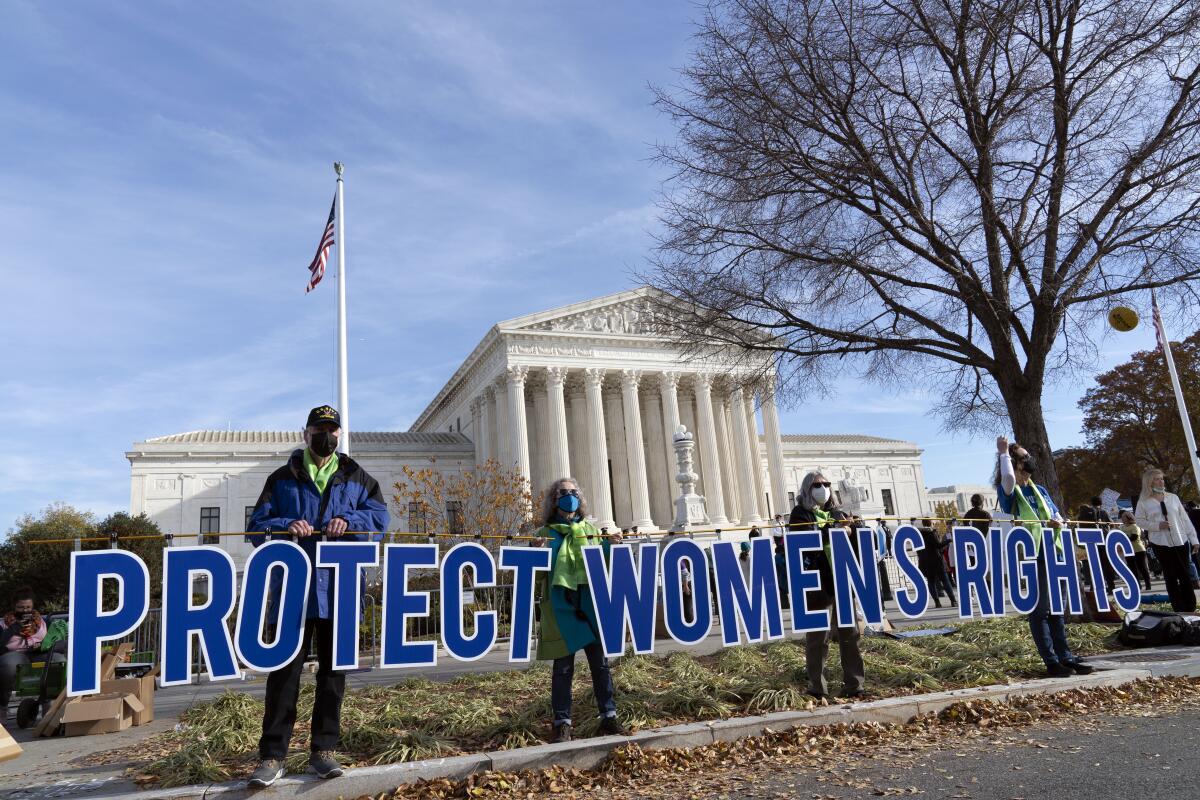Supreme Court’s conservatives on the verge of ending right to abortion

- Share via
WASHINGTON — The Supreme Court is ending the year starkly split on abortion, with the five conservatives showing all signs they will overturn Roe vs. Wade and let state lawmakers decide whether women may legally end a pregnancy.
Until this fall, it was at least possible to foresee a moderate-conservative majority coming together to set new limits on abortions later in a pregnancy, while upholding the constitutional protection for a woman to end a pregnancy in the early months.
In May, the justices voted to hear Mississippi’s appeal of a law that limited abortions to 15 weeks, well below the 24-week limit set by Roe vs. Wade. That move signaled a change, but ruling for Mississippi did not require overturning the right to choose abortion.
Such an outcome — tightening the time limit while preserving the right to abortion — required Justice Brett M. Kavanaugh or Justice Amy Coney Barrett, or both, to join with Chief Justice John G. Roberts Jr., who staked out a middle-ground position. On Roberts’ left were three liberal justices who would uphold Roe as it is, and on his right were three conservatives who indicated they would overturn it.
Since then, however, three developments have cast doubt on the prospects for a moderate retreat from full abortion rights.
First, the court, by a 5-4 vote, stood aside on Sept. 1 while Texas, the nation’s most populace red state, put into effect a law that made abortions illegal after six weeks. Known as SB 8, the law authorized private lawsuits against doctors and their clinics, and the state insisted that no one could sue in federal court to stop it because state officials had no role in enforcing the law.
The threat of lawsuits worked as intended and shut down nearly all abortions. Having lost in Texas, abortion rights advocates asked the high court to intervene. After all, the law clearly conflicted with the right to abortion as it stood for nearly 50 years, and the justices usually put on hold new laws that threaten to cause an “irreparable harm” to those affected. Roberts joined with the three liberals to block the law, but Kavanaugh and Barrett refused to join them.
Next, on Dec. 1, when the court heard arguments in the Mississippi case, only Roberts focused on the 15-week limit. Roe says “women should have a choice to terminate their pregnancy,” he said. “If it really is an issue about choice, why is 15 weeks not enough time?”
The two abortion rights lawyers dismissed the idea. They said the court must maintain the limit of 24 weeks, the point when Roe stated that a fetus may be viable and capable of living outside the womb.
More significant, Kavanaugh and Barrett ignored the issue of the time limit and repeated the arguments for overruling Roe vs. Wade entirely.
Twice, Kavanaugh summarized Mississippi’s argument that the Constitution is “silent” on abortion. If so, he said, the court should let the states decide on their own. When Julie Rikelman, the attorney for the Center for Reproductive Rights, cited the decades of precedent, Kavanaugh responded that many of the court’s greatest decisions reversed flawed and mistaken rulings, citing as a prime example Brown vs. Board of Education overruling segregation.
And last week, Kavanaugh and Barrett joined with their three conservative colleagues in an opinion that is likely to keep the Texas abortion ban in effect indefinitely.
At issue was whether the doctors and clinics could sue the state and at least some of its officials and thereby permit a federal judge to block the law. During arguments on Nov. 1, Kavanaugh sounded as if he agreed with the challengers. He said Texas had “exploited a loophole” to allow a state to defy the U.S. Constitution. Barrett said doctors had no effective way to shield themselves from ruinous lawsuits, because a hundred separate claims could be filed across Texas over one abortion.
Yet, in Friday’s decision, they again split with the chief justice and joined the three conservatives in a ruling that will keep the Texas abortion ban in effect. Roberts and the three liberals would have allowed a federal judge to block the state law.
Why can’t doctors and clinic owners sue the state to shield themselves from a law that is unconstitutional? Because of the “doctrine of sovereign immunity,” said Justice Neil M. Gorsuch, writing for the court. This generally means states are shielded from being sued in federal court, he said.
The Constitution does not mention such a shield or immunity for the states. And as Justice Sonia Sotomayor observed, it says the opposite. Article VI declares “this Constitution and the Laws of the United States shall be the supreme law of the land and Judges in every state shall be bound thereby,” regardless of contrary state laws.
Nonetheless, in 1890, the conservative high court that unraveled the Reconstruction laws and upheld racial segregation ruled that states were immune from being sued in federal court without their permission. This decision in Hans vs. Louisiana has survived as a precedent that still enjoys support among the conservatives.
In 1908, the court backtracked when railroads were threatened by aggressive state rate regulations. In the case known as Ex Parte Young, the justices said a railroad could win a federal court order blocking the rate-setting law. The workaround: The company could sue the state official tasked with enforcing the law — in that instance, Edward Young, the attorney general of Minnesota.
That peculiar doctrine formed the backdrop for the fight over the Texas abortion law. It puts a premium on finding the right person to sue. In last week’s decision, the five conservatives held that the abortion doctors could not win a federal court order by suing the Texas attorney general or the state judges and their clerks who would handle the lawsuits authorized by SB 8, because they were not tasked with enforcing the law.
In dissent, Roberts said the decision undercut the basic principle that constitutional rights are protected throughout the United States.
“The Constitution itself becomes a solemn mockery,” he wrote, quoting Chief Justice John Marshall, if states are free to “annul” the rulings of the federal courts and “destroy the rights” set out there.
“The nature of the federal right infringed does not matter; it is the role of the Supreme Court in our constitutional system that is at stake,” Roberts added.
Roberts is no liberal and has repeatedly voted against abortion rights in the past. However, as chief justice, he has often tried to steer the court on a middle path to avoid sharp and divisive rulings. But he is no longer in control.
“Now the five on his right can just abandon him,” said Harvard Law School Professor Richard Lazarus, an environmental law expert who has been a friend of Roberts for more than 40 years. Instead, he said, control rests in the hands of Justices Clarence Thomas and Samuel A. Alito Jr., conservative veterans who have long been determined to reverse the abortion rulings. “We may be seeing the early signs of a disintegration within the court itself,” Lazarus added.
It may not be until late June that the court hands down its decision in the Mississippi case, Dobbs vs. Jackson Woman’s Health. Shortly after the Dec. 1 argument, the justices met behind closed doors to vote on the outcome. During such meetings, they speak in order of seniority, beginning with the chief justice. Based on Roberts’ comments, he almost certainly voted to uphold the Mississippi law on the grounds that its 15-week limit gave women enough time to choose. Thomas, who spoke next, has argued for overturning the abortion decision since 1992, and he has never waivered.
If Kavanaugh and Barrett agreed with the chief justice, the court could issue an opinion that limits but does not overturn the right to abortion. But if they agreed with Thomas, the majority is at work on an opinion that goes much further.
Overturning Roe vs. Wade has been a chief goal of the conservative legal movement for decades. Friday’s decision was the latest sign the movement is on the verge of winning.
The success of the Texas law and its bounty-hunter provision prompted Gov. Gavin Newsom to propose that California authorize private lawsuits against makers and sellers of assault weapons. Legal experts say other copycat measures may be coming, but they are not likely to be as effective as the abortion law in Texas.
Elizabeth Wydra, president of the progressive Constitutional Accountability Center, noted that in last week’s opinion, Gorsuch did not say the Texas abortion law was unconstitutional.
“That certainly does not bode well for abortion rights,” she said, adding that the decision likely foreshadows the opinion to come in the Mississippi case.
More to Read
Get the L.A. Times Politics newsletter
Deeply reported insights into legislation, politics and policy from Sacramento, Washington and beyond. In your inbox three times per week.
You may occasionally receive promotional content from the Los Angeles Times.











